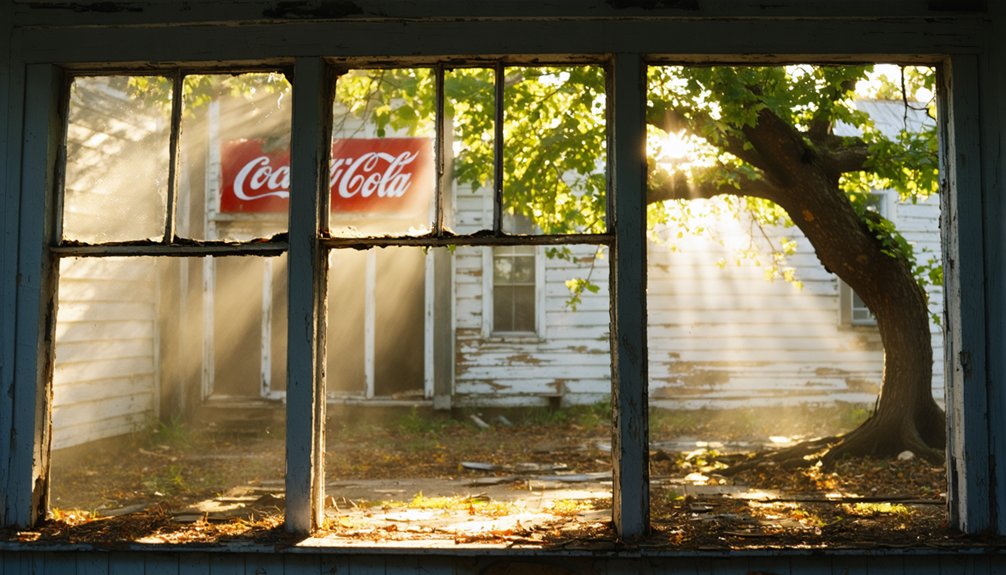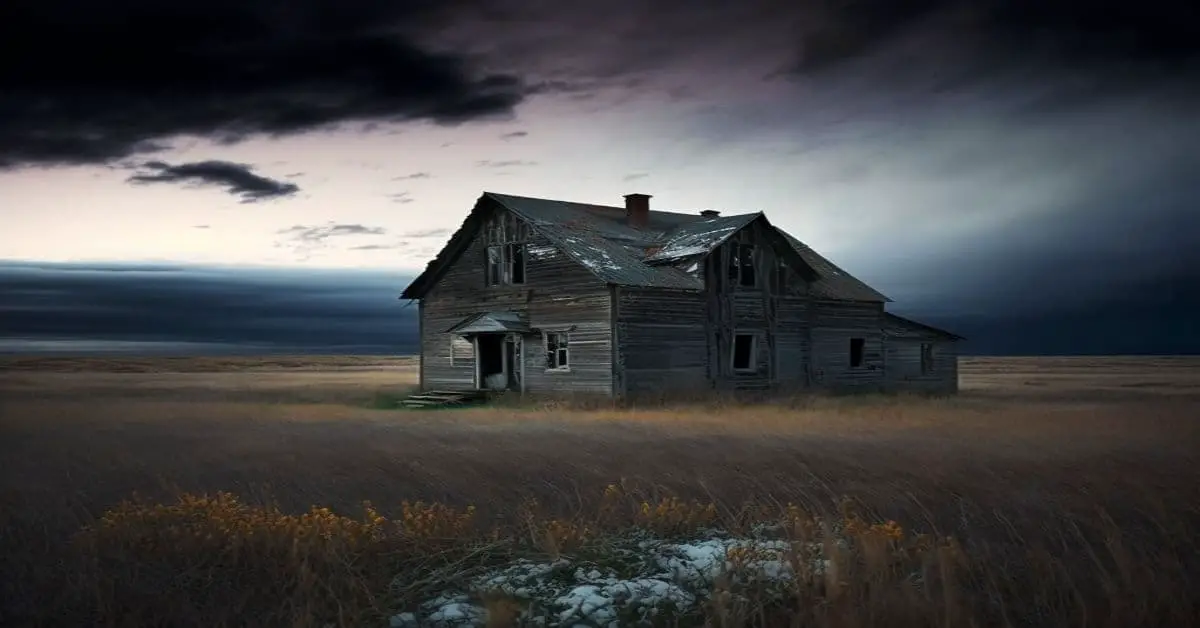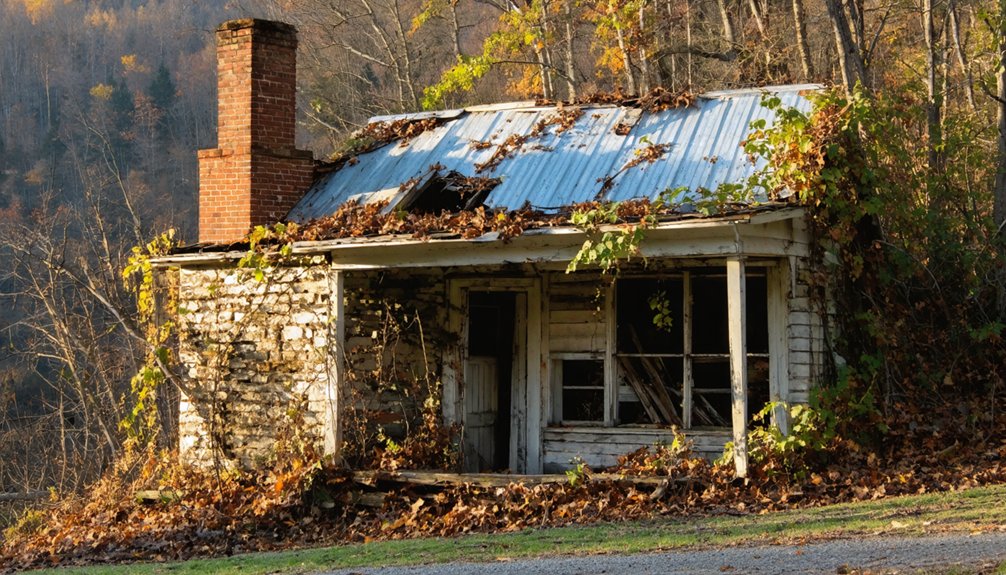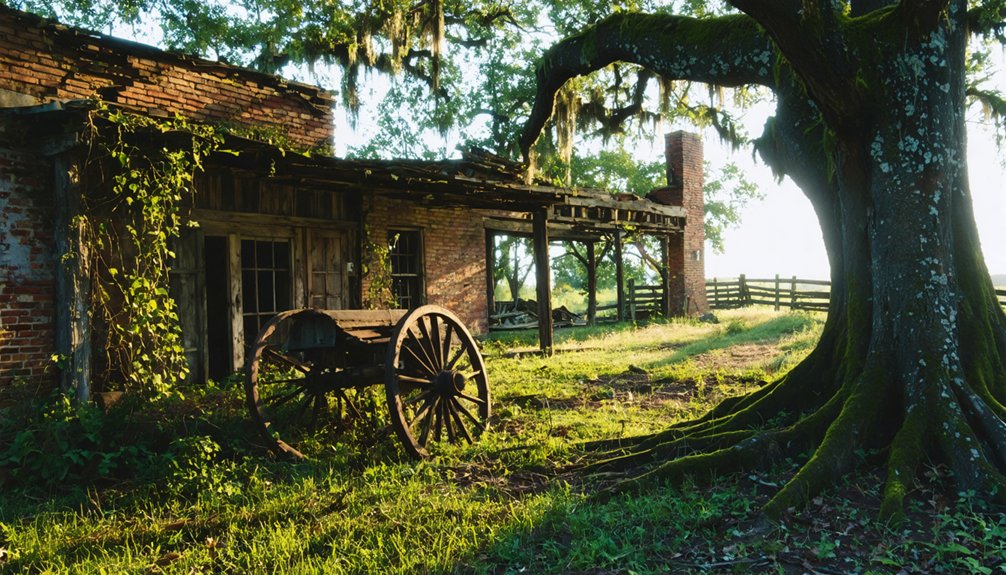You’ll find Bear, Arkansas tucked away in the Ouachita Mountains, where a gold and silver mining boom transformed a quiet settlement into a bustling town of 5,000 residents in 1882. The town flourished with hotels, saloons, and 35 mining companies, but by 1891, the mining claims proved false and Bear’s post office closed. While nature has reclaimed most structures, Bear’s story of spectacular rise and fall reveals fascinating insights into Arkansas’s mining era.
Key Takeaways
- Bear was a mining boomtown in Arkansas that peaked at 5,000 residents in the 1880s before becoming a ghost town.
- The town’s rapid decline began in 1888 when mining operations failed to find profitable gold and silver deposits.
- The closure of the post office in 1891 marked Bear’s official transformation into a ghost town.
- Thirty-five mining companies operated in Bear during its peak, but most lasted only one or two years.
- Today, Bear’s original structures are largely hidden by forest growth, though the site attracts heritage tourism.
The Birth of a Boomtown
While early settlers had already established homesteads in the Bear Mountain area before the 1880s, the discovery of potential gold and silver deposits in the Ouachita Mountains transformed this quiet rural settlement into a bustling boomtown.
From quiet farmland to gold rush boomtown, Bear Mountain’s destiny changed with whispers of precious metals in the Ouachitas.
You’ll find settler stories centered around pioneers like Larkin Melson, who initially came for the region’s rich agricultural land and hunting opportunities. Like many other communities in the state, Bear was destined to become one of Arkansas’s ghost towns.
When gold rush fever struck, the town’s character changed dramatically. Mining speculators and fortune seekers flooded the area, pushing Bear’s population to estimates between 1,200 and 5,000 residents. By 1887, thirty-five mining companies were actively operating in the area.
The once-simple settlement rapidly expanded as drugstores, saloons, and hotels sprang up to serve the growing population. A post office opened in 1882, marking Bear’s official recognition as a thriving community.
Mining Dreams and Economic Growth
Although Bear’s residents dreamed of striking it rich, the town’s economic boom rested more on speculation than actual precious metals. By 1887, you’d have found at least 35 mining companies operating in the area, with Garland County Silver Mining Co. alone issuing $5 million in stock shares.
Most mines proved unprofitable, with operations typically lasting one or two years. Mining speculation triggered rapid development as Bear’s population swelled to somewhere between 1,200 and 5,000 residents. You’d have seen new telephone exchanges, hotels, sawmills, and even a Masonic lodge spring up to serve the growing community.
But the economic bubble was built on sand – or rather, on “peculiar” black ore that proved too costly to extract and process. Early prospectors discovered this unique ore containing gold with white quartz throughout its dark layers. When fraudulent assayers’ claims were exposed, the inevitable crash followed, leaving Bear’s dreams of mineral wealth shattered.
Daily Life in Bear’s Golden Age
Despite its short-lived existence, Bear’s golden age bustled with the vibrancy of a thriving frontier town. You’d find yourself among a diverse mix of residents and travelers, maneuvering through a community where transient lifestyle met organized society.
Community gatherings centered around the town’s five hotels and numerous saloons, while the Masonic lodge provided a foundation for social bonds. Like the black bears native to Arkansas, the town’s inhabitants adapted well to the rugged frontier environment. Similar to the town of Rush Arkansas, Bear thrived during the zinc mining boom.
Hotels and saloons formed the heart of Bear’s social life, with the Masonic lodge strengthening the community’s connections.
- You could start your morning reading one of two newspapers, catching up on mining speculation and local happenings.
- Your children would attend one of the subscription schools, learning alongside other frontier families.
- You’d conduct business at the newly established post office, connecting with the outside world.
- Your evenings might include socializing at community gatherings, from lodge meetings to hotel functions.
The Fall From Glory
The rapid collapse of Bear’s fortunes began in 1888 when the promise of precious metals proved entirely false. The legendary Lost Louisiana Mine and other fraudulent claims had lured 35 mining companies to the area, but none found viable deposits.
You’d have witnessed the town’s economic fragility as stock valuations, like the Garland County Silver Mining Co.’s $5 million assessment, evaporated into nothing.
Community abandonment accelerated as businesses shuttered and residents fled. The post office’s closure on September 30, 1891, marked Bear’s official decline.
Hotels, sawmills, and saloons that once bustled during the boom years fell silent. Local newspapers, including the Bear City Times and Arkansas Mining Journal, ceased operations. The area’s decline mirrored the fate of the native black bears, whose numbers had dwindled to just 25 bears by 1940. Thanks to a successful reintroduction program in 1958, the region’s black bear population would eventually recover.
Without economic diversification or infrastructure to sustain it, Bear joined the ranks of Arkansas’s forgotten ghost towns.
Legacy and Modern-Day Remnants
While Bear’s physical structures have largely vanished beneath forest growth, its legacy endures through historical records and cultural memory.
You’ll find Bear’s story preserved in local historical societies and state encyclopedias as a prime example of mining speculation‘s impact during Arkansas’s gold rush era of the 1880s.
The town has experienced renewed interest and construction in recent years, bringing fresh life to this historic location.
If you’re exploring Bear’s heritage today, you’ll discover:
- Historical registries and publications that maintain awareness despite minimal physical remains
- Heritage tourism opportunities combining hiking near Bear Mountain with mining history
- Educational programs in Garland County that use Bear’s story to illustrate boom-and-bust cycles
- Documentation in newspapers like *Bear City Times* and *Arkansas Mining Journal* that provide firsthand accounts of frontier mining ventures
Frequently Asked Questions
Were There Any Notable Crimes or Lawlessness During Bear’s Boom Period?
You won’t find documented crime incidents or law enforcement records from Bear’s boom period. Despite having saloons and rapid growth typical of mining towns, there’s no evidence of notable lawlessness.
What Happened to the Buildings and Materials After the Town Was Abandoned?
You’d be surprised what vanished: the abandoned structures were either dismantled and moved to other towns, fell victim to decay and fires, or disappeared entirely without historical preservation efforts protecting them.
Did Any Original Bear Residents’ Descendants Still Live in Garland County Today?
You won’t find documented descendant stories linking original Bear residents to current Garland County. While historical connections suggest some families might’ve stayed, there’s no concrete evidence tracing direct lineage today.
What Was the Average Price of Property During Bear’s Peak Years?
You won’t find exact property values from Bear’s peak years, as historical records don’t preserve specific prices. Economic factors like mining speculation likely inflated prices before the town’s eventual collapse.
Were There Any Documented Native American Settlements in Bear Before the Boomtown?
While there’s no direct record of Native American settlements specifically in Bear, you’ll find archaeological evidence of indigenous presence in the broader northwest Arkansas region before Bear’s boomtown era.
References
- https://encyclopediaofarkansas.net/entries/bear-garland-county-4058/
- https://en.wikipedia.org/wiki/List_of_ghost_towns_in_Arkansas
- https://aymag.com/arkansas-backstories-ghost-towns/
- https://www.barefeetonthedashboard.com/2012/09/family-travel-visiting-old-west-ghost/
- https://kids.kiddle.co/List_of_ghost_towns_in_Arkansas
- https://arkadelphian.com/2023/09/26/history-minute-arkansas-as-the-bear-state/
- https://arkansashistory.online/2020/08/15/mining-boom/
- https://encyclopediaofarkansas.net/entries/silver-mining-3182/
- https://www.mindat.org/loc-8592.html
- https://www.argenweb.net/marion/history/history-marion-co-ar-29-mining-mines.html



